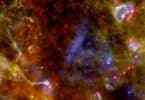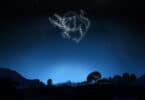Coma Berenices, a constellation often overlooked, is a fascinating feature in our night sky.
It’s known as The Queen’s Hair, a name steeped in history dating back to ancient times when Queen Berenice II of Egypt promised to sacrifice her hair to the gods if her husband returned safely from war.
Upon his return, her locks were dedicated at a temple but mysteriously disappeared, later to be commemorated by the astronomer Conon of Samos as a constellation.

Today, we find Coma Berenices nestled among its more famous celestial neighbors.
This inconspicuous constellation lacks the bright stars that form the recognizable patterns nearby, yet it holds a treasure trove of galaxies within its boundaries.
Its starry expanse is best observed under dark skies, where we can immerse ourselves in exploring the myriad of distant galaxies and star clusters it embraces.
Discovering Coma Berenices

Coma Berenices has a storied past steeped in mythology. According to Ancient Greek legend, this cluster of stars represented the cascading golden locks of Queen Berenice II of Egypt.
As a tribute to her husband, King Ptolemy III, she offered her hair to the gods for his safe return from war.
The constellation is said to be the deification of those very locks, which were reputedly placed in the sky by Aphrodite to honor the queen’s sacrifice.
Recognition as a Constellation
It wasn’t until the early modern period that Coma Berenices was distinguished as a standalone constellation.
Astronomer Johannes Hevelius formally introduced it in his star atlas, Prodromus Astronomiae, in 1690.
This marked a pivotal moment for the cluster’s identity, as it transitioned from being considered part of Leo’s tail into its own constellation.
Subsequent star maps and catalogs continued to adopt Hevelius’s delineation, solidifying Coma Berenices’ place among the recognized constellations.
Stellar Composition

What Are The Main Stars of Coma Berenices?
Diadem (Alpha Comae Berenices): A binary star system consisting of two main sequence stars similar in brightness.
Gamma Comae Berenices: A giant yellow star, it’s about 170 light-years from Earth and significantly brighter than our sun.
Beta Comae Berenices: A dwarf star much like our own sun, albeit slightly larger and more luminous.
Galaxies Within the Constellation
- Black Eye Galaxy (M64): Noted for the dark band of absorbing dust in front of the galaxy’s bright nucleus.
- Needle Galaxy (NGC 4565): A spiral galaxy seen edge-on, featuring a prominent dust lane in its disk.
Star Clusters
- Melotte 111: An open cluster that is easily visible to the naked eye, containing about 40 brighter stars distributed across a wide area.
- Coma Star Cluster: This is not a traditional star cluster. Instead, it is a sparse star cluster that consists of approximately 50 stars spread out over a large region of space.
Observing Coma Berenices

Best Time to View
The optimal period for observing Coma Berenices is during the Northern Hemisphere’s spring months, from March to May.
This is when it reaches its highest point in the sky and is most visible.
We can expect favorable viewing conditions on clear nights, particularly when the moon is not full, to avoid its overpowering brightness.
Locating the Constellation
Finding Coma Berenices can initially be challenging due to its lack of bright stars, but once known, it’s easily identified.
- Start with the Big Dipper: Locate the curved handle of the Big Dipper.
- Follow the Arc: Trace the arc of the handle to the bright star Arcturus in Boötes.
- Continue the Curve: Extend the imaginary line to the star Spica in Virgo.
- Locate by Triangulation: Coma Berenices lies roughly equidistant from Denebola in Leo to the west and Vindemiatrix in Virgo to the south-east.
Visual Guide to Locating Coma Berenices:
- Big Dipper’s Handle: Curve → Arcturus
- Arc to Spica
- Equidistance: Denebola (Leo) ← Coma Berenices → Vindemiatrix (Virgo)
With the clear skies of spring and these steps, we’ll be well equipped to enjoy the celestial cascade of the Queen’s Hair.






